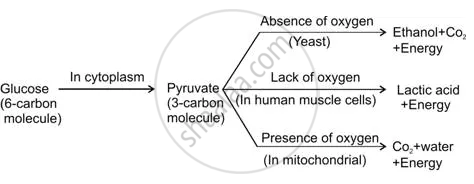Advertisements
Advertisements
प्रश्न
What are the different ways in which glucose is oxidized to provide energy in various organisms?
उत्तर १
At first glucose (6 carbon molecules) is broken in the cytoplasm of cells of all organisms. This process yields a 3 carbon molecule compound called pyruvate. Further break down of pyruvate takes place in different manners in different organisms.

- Anaerobic Respiration: This process takes place in absence of oxygen, e.g. in yeast during fermentation. In this case pyruvate is converted into ethanol and carbon dioxide.
- Aerobic Respiration: In aerobic respiration, breakdown of pyruvate takes place in presence of oxygen to give rise 3 molecules of carbon dioxide and water. The release of energy in aerobic respiration is much more than anaerobic respiration.
- Lack of Oxygen: Sometimes, when there is lack of oxygen, especially during vigorous activity, in our muscles, pyruvate is converted into lactic acid (3 carbon molecule compounds). Formation of lactic acid in muscles causes cramp.
उत्तर २
Glucose is oxidised in two ways to provide energy.
- Aerobic respiration: Glucose is completely oxidised to carbon dioxide and water in the presence of oxygen, with the release of a considerable amount of energy. This type of oxidation occurs in most of the living organisms such as human beings, birds, snakes, frogs, fish, etc.
- Anaerobic respiration: This type of respiration occurs in the absence of oxygen. In this type of oxidation, glucose is partially oxidised to ethanol and carbon dioxide (yeast and other bacteria) or lactic acid (muscles during physical exercise and some bacteria) with the release of a small amount of energy.
APPEARS IN
संबंधित प्रश्न
The breakdown of pyruvate to give carbon dioxide, water, and energy takes place in ______.
Name one substance which is produced in anaerobic respiration by an organism but not in aerobic respiration.
What is the name of tiny air-sacs at the end of smallest bronchioles in the lungs?
What is the other name of wind-pipe?
Explain why, a land plant may die if its roots remain waterlogged for a long time.
Name the type of respiration in which the end product is:
C2H5OH and CO2
Give one example where such a respiration can occur.
Describe the process of respiration in the following part of a plant:
Leaves
Draw a labelled diagram of the human respiratory system.
Give the main points of difference between respiration in plants and respiration in animals.
During respiration, the exchange of gases takes place in:
Which of the following statements are true about respiration?
(i) during inhalation, ribs move inward and diaphragm is raised.
(ii) the gaseous exchange takes place in the alveoli.
(iii) haemoglobin has greater affinity for carbon dioxide than oxygen.
(iv) alveoli increase surface area of the exchange of gases
Which of the following is most likely to have a much higher breathing rate?
In cockroaches, air enters the body through:
An animal in which the oxygenation of blood does not take place in the lungs is:
Veins and arteries carry blood. Which of these carry blood back to the heart?
Match the items in Column I with the ones most appropriate in Column II. Rewrite the matching pairs.
|
Column I |
Column II |
|
(a) Alveoli |
(i) where aerobic respiration takes place |
|
(b) Bronchioles |
(ii) lined with hair |
|
(c) Nasal Chamber |
(iii) diffusion of gases |
|
(d) Bronchi |
(iv) small air tubes |
|
(v) an inverted Y shaped tube |
|
|
(vi) a common passage for food and air |
State one function of the following:
Ciliated epithelium lining the respiratory tract
State one function of the following:
Mitochondria
Give suitable explanation for the following :
Why does a person feel breathlessness at higher altitudes?
Give Suitable Explanation for the Following :
Why do you shiver and why do your teeth chatter when it is very cold in winter?
Given below is an overall chemical reaction of a certain process:
C6H12O6 →LacticAcid+2ATP+Heat energy
Name the process.
With regard to the respiratory system and the process of respiration in man, answer the following question:
What is meant by :
- Residual air and
- Dead air space
Why is respiration essential for life?
Respiration refers to ____________.
Identify the CORRECT sequence of events for the transport of respiratory gases.
The major fraction of CO2 released during cellular respiration is transported by the blood to the lung capillaries ______
Which of the following indicates the shift of oxyhaemoglobin dissociation curve due to change in ppC02 in blood?
____________ is the maximum amount of air that the lungs can hold after a maximum forceful inspiration.
Glycolysis process occurs in which part of the cell?
Which is the correct sequence of air passage during inhalation?
Name the energy currency in the living organisms. When and where is it produced?
The oxygen dissociation curve is a sigmoid curve and it shifts towards the right due to ______.
List the similarities between aerobic and anaerobic respiration.
